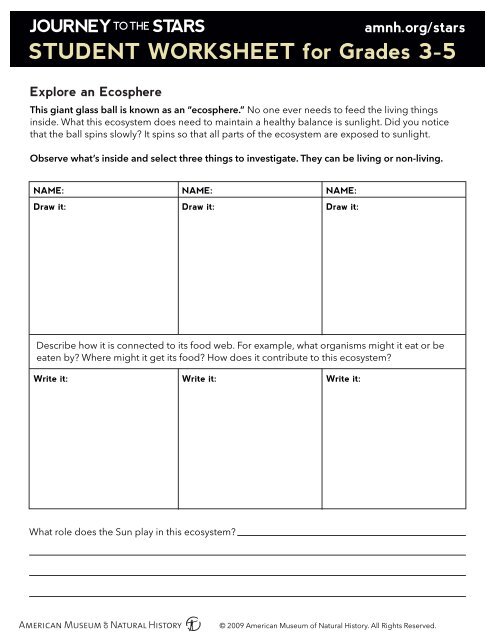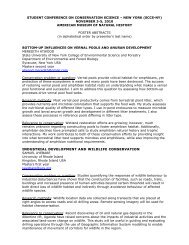STUDENT WORKSHEET for Grades 3-5 - American Museum of ...
STUDENT WORKSHEET for Grades 3-5 - American Museum of ...
STUDENT WORKSHEET for Grades 3-5 - American Museum of ...
- No tags were found...
Create successful ePaper yourself
Turn your PDF publications into a flip-book with our unique Google optimized e-Paper software.
Explore an Ecosphereamnh.org/stars<strong>STUDENT</strong> <strong>WORKSHEET</strong> <strong>for</strong> <strong>Grades</strong> 3-5This giant glass ball is known as an “ecosphere.” No one ever needs to feed the living thingsinside. What this ecosystem does need to maintain a healthy balance is sunlight. Did you noticethat the ball spins slowly? It spins so that all parts <strong>of</strong> the ecosystem are exposed to sunlight.Observe what’s inside and select three things to investigate. They can be living or non-living.NAME:Draw it:NAME:Draw it:NAME:Draw it:Describe how it is connected to its food web. For example, what organisms might it eat or beeaten by? Where might it get its food? How does it contribute to this ecosystem?Write it:Write it:Write it:What role does the Sun play in this ecosystem?© 2009 <strong>American</strong> <strong>Museum</strong> <strong>of</strong> Natural History. All Rights Reserved.
<strong>STUDENT</strong> <strong>WORKSHEET</strong> <strong>for</strong> <strong>Grades</strong> 3-5Explore an Ecosphereamnh.org/starsANSWER KEYThis giant glass ball is known as an “ecosphere.” No one ever needs to feed the living thingsinside. What this ecosystem does need to maintain a healthy balance is sunlight. Did you noticethat the ball spins slowly? It spins so that all parts <strong>of</strong> the ecosystem are exposed to sunlight.Observe what’s inside and select three things to investigate. They can be living or non-living.NAME:Draw it:NAME:Draw it:NAME:Draw it:Possible student selections include the shrimp, algae, rock, and bacteria (microscopic).Describe how it is connected to its food web. For example, what organisms might it eat or beeaten by? Where might it get its food? How does it contribute to this ecosystem?Write it:Write it:Write it:Answers may include: All the elements found in the ecosphere are important to its function. Life functionsinside just as it does on the Earth. The shrimp, algae, and the bacteria have key roles that directly affecteach other and their roles in the ecosphere. The shrimp breathe out carbon dioxide (CO 2 ) an elementessential <strong>for</strong> the algae, which use it together with light to produce oxygen. Algae produce oxygen onlywhen light is available, during the day. No oxygen is made in the dark (or at night). Shrimp and bacterianeed oxygen to breathe. When it is dark, they consume the oxygen available while none is being made.This is why there are not too many living things inside <strong>of</strong> the ecosphere; there would not be enoughoxygen at night to keep them alive.The shrimp eat the algae, bacteria, and even their own shed exoskeleton. The shrimp eats not all bacteria,some find great hiding places in the rocks, gravel, and plant life in the ecosphere. These bacteria breakdown waste materials and recycle them back into the ecosystem.What role does the Sun play in this ecosystem?Answers may include: The Sun is the starting point <strong>for</strong> the food chain. The light energy that it provides is captured bythe algae and used along with carbon dioxide to provide food and oxygen <strong>for</strong> the shrimp. The shrimp, which cannotcreate their own food, get their energy from the Sun by eating the algae. The waste that the shrimp produce is brokendown by the bacteria and recycled back into the ecosystem.© 2009 <strong>American</strong> <strong>Museum</strong> <strong>of</strong> Natural History. All Rights Reserved.

















